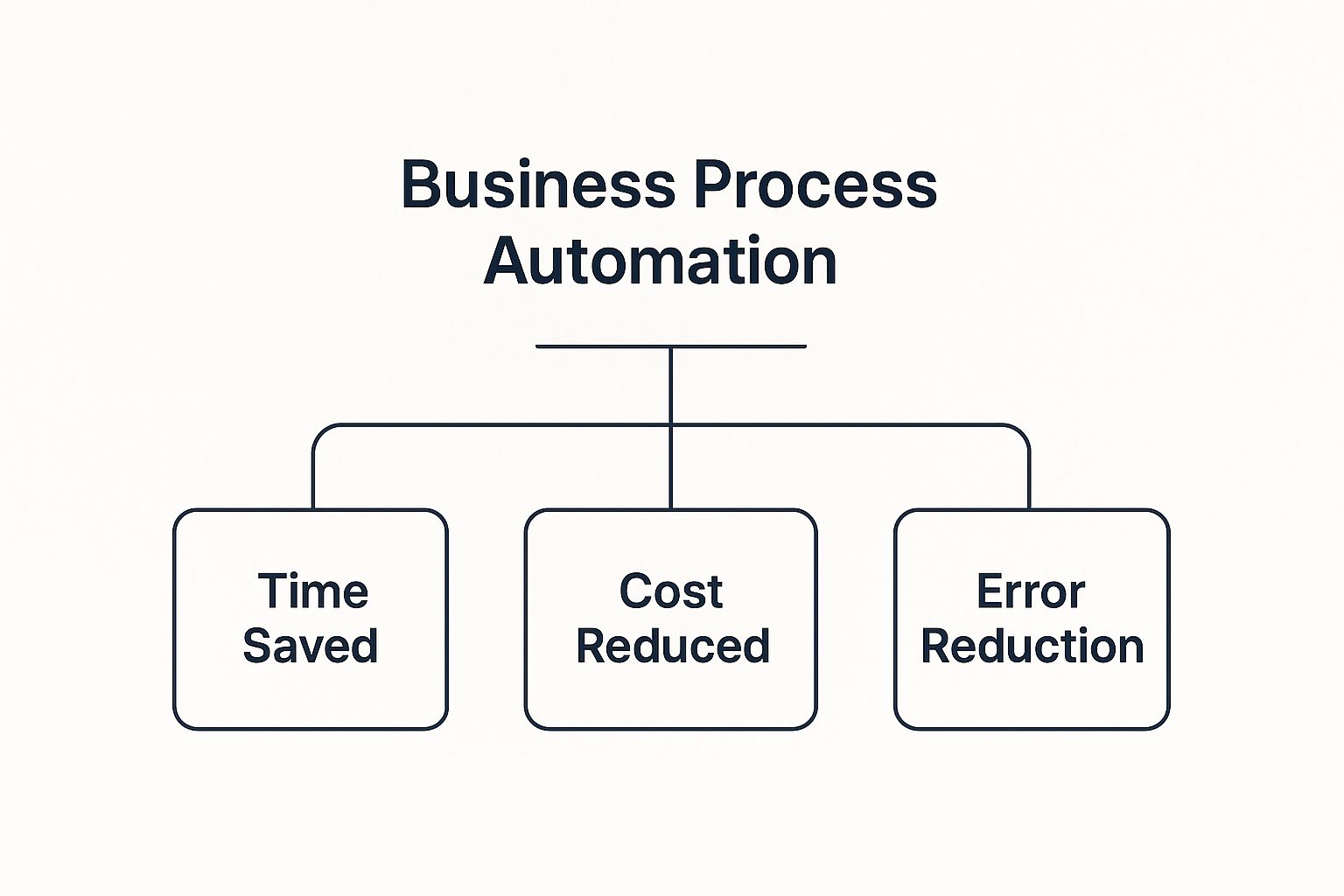Unlocking Business Process Automation Benefits
Discover the top business process automation benefits, from major cost savings to improved efficiency. Learn how automation transforms your operations.

At its heart, business process automation delivers on a few simple but incredibly powerful promises: it slashes operational costs, supercharges team productivity, and all but eliminates human error. When you hand over the repetitive, soul-crushing tasks to technology, you free up your people to focus on the work that actually matters—the strategic thinking and creative problem-solving that drives real growth.
What Are the Real Benefits of Business Process Automation?
Let's cut through the jargon and get straight to what automation actually does for a business. Think of your current manual workflows like a city street grid during rush hour—everything is congested, inefficient, and prone to costly fender benders. Business Process Automation (BPA) is like building a multi-lane highway. It doesn't just make things move faster; it creates a smarter, more resilient, and scalable foundation for your entire operation.
This guide will break down the tangible benefits that directly impact your bottom line and overall company health. We'll show you exactly how BPA turns abstract ideas like "efficiency" into measurable, real-world results.
Core Pillars of Automation Value
The advantages of BPA aren't just a random collection of perks. They fit into three core categories that work together to create a powerful cycle of improvement that ripples through every single department—from finance and HR to customer service and marketing.
- Operational Efficiency: Automating routine work frees your team from drudgery. Instead of mind-numbing data entry, they can focus on high-value activities that demand their creativity and expertise. This means projects get done faster and overall output soars.
- Financial Improvement: Fewer errors and less need for manual rework translate directly into lower operational costs. This leads to a stronger Return on Investment (ROI) and a leaner, more profitable organization. It's that simple.
- Enhanced Quality and Consistency: An automated system follows the rules perfectly, 100% of the time. This guarantees that your processes are standardized, your data is accurate, and your compliance is solid. It's the foundation for better decision-making and a top-notch customer experience.
The following infographic visualizes how these key benefits all stem from the central goal of automation.

As you can see, the main goals are saving time, cutting costs, and getting rid of errors. Together, these create a much more robust and competitive business. Now, let’s dig into each of these benefits in more detail.
Business Process Automation Benefits at a Glance
To quickly summarize how these advantages connect to real-world outcomes, here’s a high-level overview.
| Benefit Category | Primary Impact on the Business | Example Application |
|---|---|---|
| Operational Efficiency | Frees up employee time for strategic tasks, leading to higher productivity and faster turnaround. | Automating the process of creating and sending monthly invoices to clients. |
| Cost Reduction | Minimizes expenses related to manual labor, rework due to errors, and inefficient resource use. | Using software to automatically approve expense reports that fall within policy limits. |
| Error Reduction | Ensures consistency and accuracy by removing the risk of human error from repetitive tasks. | Automating data entry from lead forms into a CRM to prevent typos and missed fields. |
| Scalability | Allows the business to handle increased workloads without a proportional increase in staff or cost. | An e-commerce system that automatically processes 100 or 10,000 orders a day. |
| Compliance & Control | Creates clear, auditable records and ensures that all processes adhere to regulatory standards. | A system that automatically logs all access to sensitive customer data for security audits. |
| Customer Experience | Provides faster, more accurate responses and resolutions to customer inquiries and issues. | An automated chatbot that instantly answers common customer questions 24/7. |
Each of these categories represents a significant opportunity for improvement. Let’s dive deeper into how each one plays out in a real business setting.
Boosting Your Team's Efficiency and Productivity
One of the first things you'll notice after implementing business process automation is just how much more your team can get done. It’s a direct and immediate impact. Automation is brilliant at handling the mind-numbing, high-volume tasks that eat away at your team's day—think data entry, invoice processing, or routing support tickets.
When you take those tasks off their plate, something incredible happens. Your best people are suddenly free to focus on the work that actually requires a human touch. They can dedicate their time and expertise to strategic planning, creative problem-solving, and building real relationships with customers. It's not just about speeding things up; it's about fundamentally changing the kind of work your team does, leading to more growth and a more motivated, engaged workforce.

From Manual Drudgery to Automated Success
Let's look at a classic example: onboarding a new employee. In many companies, this is a messy, manual process. HR is chasing down paperwork, IT is scrambling to set up accounts, and managers are trying to coordinate training. It’s a process riddled with potential delays and mistakes, creating a rocky start for the new hire.
Now, picture that same process with automation:
- Step 1: The Trigger. The moment HR marks a candidate as "hired" in the system, a workflow kicks off.
- Step 2: A Flurry of Action. Instantly, IT gets an automated request to create accounts and order a laptop. The new hire receives a welcome email with all their digital paperwork ready to go. The manager is prompted to schedule orientation meetings.
- Step 3: A Perfect Welcome. A process that used to take days of back-and-forth emails is now handled in minutes. The result is a smooth, professional welcome that makes a great first impression.
This principle holds true everywhere, from the finance department to the marketing team. Automation gets information and tasks flowing smoothly, removing the frustrating bottlenecks that kill momentum and drain employee morale. Ultimately, your teams can achieve more in less time, without burning out.
Unlocking Higher-Value Work
This boost in efficiency isn't just about doing the same old tasks faster. It's about empowering your team to contribute in more meaningful ways. The data backs this up. For instance, over 90% of IT professionals report that automation allows employees to shift their focus to more complex, strategic work.
Furthermore, businesses have seen savings of around 30% in cost-per-hire simply by automating parts of their screening and hiring workflows.
When your people can trust automated systems to handle the routine stuff, they’re free. A customer service agent can spend less time assigning tickets and more time solving a tricky client problem. A financial analyst can focus on forecasting and analysis instead of manually pulling numbers for reports. The key features of advanced platforms are built precisely for this purpose—to help your team work smarter, not harder.
This is where the real magic of automation lies. You're not just making your processes more efficient; you're transforming your employees from task-doers into strategic thinkers who can drive your business forward.
Achieving Significant Cost Savings and ROI
Beyond just making your team more efficient, one of the most compelling reasons to embrace business process automation is its direct and measurable impact on your bottom line. Automation is a powerful engine for cutting costs, but the savings go much deeper than simply trimming the payroll. It systematically eliminates the hidden financial drains that quietly chip away at your profits.
Think of your manual processes as a leaky bucket. You might not notice the small, individual drips, but over time, they add up to a significant loss. Automation plugs those leaks—the costly rework from human error, the bloated operational overhead, and the inefficient use of your team's time—to create a much more financially sound operation.

Here, we’ll get into the clear financial case for automation and explore how it delivers a strong Return on Investment (ROI), building a leaner, more profitable business along the way.
How Automation Directly Reduces Costs
Automation’s power to save money comes from several angles. It’s not just about doing things faster; it's about doing them smarter and with fewer resources. This multi-faceted approach is what makes the financial upside so substantial.
Here are the main ways automation will slash your expenses:
- Minimized Rework and Error Correction: Manual data entry is a breeding ground for typos, misplaced decimals, and all sorts of incorrect information. Every single one of those mistakes costs time and money to track down and fix. Automation, on the other hand, performs tasks with perfect accuracy every time, eliminating the high cost of rework.
- Lowered Operational Overhead: Think about all the physical resources consumed by manual work—paper, printer ink, file cabinets, and the employee hours spent managing it all. Automation digitizes and streamlines these workflows, drastically reducing the overhead needed to simply keep the lights on.
- Optimized Resource Allocation: When your most skilled employees are stuck doing repetitive, administrative tasks, you're not getting the full value of their expertise. Automation frees them up to focus on strategic initiatives that actually generate revenue, ensuring your payroll dollars are invested in high-impact work.
By tackling these core areas, automation creates a ripple effect of savings that spreads across the entire organization.
Calculating the Return on Your Investment
Getting an automation system up and running is an investment, not just an expense. The key is to look at the long-term financial picture. Return on Investment is the metric that quantifies the value you get back, and for automation, the numbers are overwhelmingly positive.
For example, robotic process automation (RPA) is known to produce a very healthy ROI, often ranging from 30% to as high as 200% within the first year alone. Companies that jump in see an average operating cost reduction of 22%, proving its immediate financial viability.
When you're evaluating a potential automation project, it's crucial to consider all the financial gains, not just the obvious ones. The true ROI comes from a combination of direct cost savings, productivity boosts, and the strategic advantages that come from being a more agile company.
Understanding your potential savings can help you explore automation tools with confidence, and you might find that seeing the pricing of different platforms makes the investment case even clearer. This complete view is exactly why automation has become a cornerstone of modern financial strategy for growing businesses.
Slash Errors and Boost Data Accuracy
Let's be honest, manual data entry is where mistakes happen. A single misplaced decimal, a typo in an address, or the wrong product code—these small slips can cause huge problems. You end up with flawed financial reports, packages sent to the wrong place, and unhappy customers. One of the biggest wins with automation is its power to virtually eliminate these human errors.
Think of an automated system as your most consistent employee. It never gets tired, distracted, or has an off day. It just follows the rules you give it, perfectly, every single time. This is how you achieve a level of data accuracy that's simply not possible when people are doing the same repetitive tasks over and over.
That incredible consistency is the key to maintaining trustworthy data across your entire company.
Create a Single Source of Truth
When data gets passed around and re-typed manually, you inevitably end up with different, conflicting versions of reality. The CRM has one address for a customer, but an old invoice has another. Which one is right? This kind of confusion leads to expensive mistakes.
Automation fixes this by creating what we call a "single source of truth."
An automated workflow makes sure that when a piece of information is updated in one system, it’s instantly and correctly updated everywhere else.
- Order Processing: Instead of someone manually typing in an order, an automated system pulls the customer's info directly from your CRM, checks inventory levels in your warehouse system, and confirms payment. The risk of someone misreading an order detail vanishes.
- Data Migration: Moving large amounts of data between platforms is a classic error trap. Automation can map the fields and transfer thousands of records without a single mistake in a matter of minutes—a job that would take a person days and would almost certainly contain errors.
By unifying your data this way, you remove the guesswork. Everyone, from sales to shipping, is working from the same accurate playbook.
How Precision Impacts Your Bottom Line
This demand for accuracy is exactly why automation technologies are booming. One area seeing massive growth is Robotic Process Automation (RPA), which uses software "bots" to handle structured digital tasks. The global RPA market hit a value of $22.79 billion in 2024 and is expected to grow at an astonishing CAGR of 43.9% from 2025 to 2030, all driven by the need for error-free work. You can see more RPA adoption statistics on flobotics.io.
Ultimately, clean data is the bedrock for smarter business strategies. Whether you're trying to forecast sales or build a machine learning model, the quality of your results depends entirely on the quality of your initial data. If you want to use data to fuel growth, you first have to trust it. You can learn more about this in our guide to the essentials of enterprise data analytics. Getting rid of manual errors is the first, most critical step toward building a more intelligent and resilient business.
4. Scale Your Business with Greater Agility

Growth should be exciting, but for many businesses, it’s a source of chaos. When you're running on manual processes, every new customer or order adds a proportional amount of work, creating bottlenecks that drag everything to a halt. You're left with a tough choice: either hire more people just to keep up, or watch your service quality start to slip.
This is where automation really shines. It breaks that direct link between growth and manual effort, building a flexible foundation that can handle a much bigger workload. Think of manual systems like building on sand—unstable and prone to shifting under pressure. Automated workflows are the concrete foundation; they provide a solid structure that can support massive growth without cracking.
When you have that solid base, you can handle a sudden surge in business without a corresponding surge in headcount or resources.
Adapt to Market Demands on the Fly
Today's markets move fast. A new competitor can pop up overnight, customer expectations can pivot in an instant, and new opportunities can appear without warning. If you’re bogged down by manual processes, you’re simply too slow to react. You're stuck in rigid, person-dependent workflows that are a nightmare to change.
Automation flips the script, making your entire operation more flexible.
- Launch New Services Faster: Need to introduce a new product? Instead of designing a new manual process and training your team from scratch, you can simply clone and tweak an existing automated workflow. What took weeks now takes hours.
- Respond to Customer Needs: Automated systems can pull in and analyze customer data in real time. This lets you spot trends and adjust your offerings to meet changing demands with incredible speed.
- Outmaneuver the Competition: While your competitors are stuck in meetings trying to retrain their staff, your automated system can be reconfigured and deployed in a single afternoon.
This kind of operational agility means you can seize opportunities while everyone else is still trying to catch up.
Grow Without Sacrificing Quality
One of the biggest fears during rapid growth is that the quality you’re known for will suffer. More orders can lead to more shipping errors. More customer inquiries can lead to longer wait times. It's a common problem because people, unlike machines, get overwhelmed.
Automation ensures your standards for quality and consistency hold steady, no matter the volume. An automated order fulfillment process, for instance, will handle its 10,000th order with the exact same precision as its first.
That reliability is absolutely essential for protecting your brand's reputation as you scale. By getting rid of the friction and limits of manual work, automation makes growth a smooth, predictable, and profitable journey.
5. Strengthen Compliance and Manage Risk
Navigating the web of regulatory compliance can feel like a high-stakes tightrope walk. New rules pop up constantly—think GDPR for data privacy or SOX for financial reporting—and a single misstep can cost you dearly in penalties and reputation. This is where automation really shines, turning risk management from a source of constant anxiety into a predictable, manageable part of your operations.
When you rely on people to handle compliance manually, you're betting on them to remember and perfectly execute every single rule, every single time. That's a huge gamble. Automation, on the other hand, embeds your business rules directly into the workflow. It doesn't get tired, have an off day, or forget a crucial step; it just runs the process exactly as you designed it, ensuring every action hits the mark.
That kind of precision is a game-changer, especially in heavily regulated fields where there's zero room for error.
Build an Unbreakable Audit Trail
The moment you hear the word "audit," does your team start scrambling to find paper trails and piece together old email chains? It doesn't have to be that way. Automation creates a crystal-clear, unchangeable audit trail for every action taken. Every step within an automated process is logged, timestamped, and tied to a specific person or system, giving you a transparent record of who did what, and when.
This digital logbook is your best friend when it comes to compliance:
- Painless Audits: Forget spending weeks digging through files. You can generate detailed reports in minutes to prove you're following the rules.
- Total Accountability: There’s no finger-pointing. The logs show exactly who approved what and when, leaving no room for doubt.
- Early Warning System: By reviewing these logs, you can spot potential compliance weak spots or process jams before they blow up into real problems.
By making sure every required step is followed and documented without fail, automation turns a dreaded audit into just another routine check-in.
Compliance in the Real World
Let's look at how this plays out in a typical accounts payable department. Manually, an employee gets an invoice, emails it around for approval, and then types the details into the accounting software. There are so many places for things to go wrong—a typo, a missed approval, a lost email. It’s a compliance accident waiting to happen.
Now, picture that with automation. The system automatically pulls in the invoice, routes it to the right manager based on preset rules (like the invoice amount), and once approved, posts it directly to the general ledger. This doesn't just get rid of data entry mistakes; it guarantees that your approval policies are followed to the letter, every single time, creating a rock-solid record for auditors.
It’s the same story with data privacy regulations like GDPR. Automation can manage customer consent, process data deletion requests, and lock down access to sensitive information. By building these rules directly into your systems, you shift from hoping your team is compliant to knowing they are. This systematic, built-in integrity is one of the most powerful benefits business process automation brings to the table.
To see the difference side-by-side, let's compare the old way with the new.
Manual vs. Automated Processes for Compliance
This table breaks down how automation fundamentally changes the game for compliance and risk management, turning high-risk manual tasks into secure, automated functions.
| Compliance Area | Challenges with Manual Processes | Advantages of Automated Processes |
|---|---|---|
| Audit Trails | Scattered paper trails, email chains, and spreadsheets that are difficult and time-consuming to assemble. Prone to human error and missing information. | A complete, timestamped digital log of every action is created automatically. Provides a single source of truth for auditors, available on demand. |
| Policy Enforcement | Relies on employee memory and diligence. Inconsistent application of rules leads to non-compliance risks and potential security breaches. | Rules and policies are hard-coded into the workflow. The system enforces them consistently without fail, ensuring 100% adherence. |
| Access Control | Permissions are often managed manually, leading to delays and the risk of unauthorized access to sensitive data. Revoking access can be slow. | Access rights are granted or revoked automatically based on roles and triggers (e.g., employee offboarding). This secures data in real-time. |
| Reporting | Generating compliance reports is a slow, manual task involving data consolidation from multiple sources. Reports can be outdated by the time they are ready. | Detailed, real-time compliance reports can be generated with a single click. Dashboards provide a live view of compliance status and potential issues. |
Ultimately, the choice is between a system that's fragile and dependent on human perfection and one that's resilient, consistent, and built for the complexities of modern regulation.
Got Questions About Business Automation? Let's Clear Things Up.
After digging into all the ways automation can help a business, you're probably left with a few practical questions. That's completely normal. This is where we'll tackle the most common things people ask when they start thinking about bringing automation into their own company, from the tech involved to how it actually affects the team.
What's the Real Difference Between BPA and RPA?
It's easy to get these two mixed up, but the distinction is pretty simple when you think about it.
Business Process Automation (BPA) is the big-picture strategy. It’s about looking at an entire workflow from start to finish—say, from a customer placing an order to it being shipped—and redesigning it to be as efficient as possible. This often means getting different systems, like your CRM and inventory software, to talk to each other seamlessly.
Robotic Process Automation (RPA), on the other hand, is a specific tool you use to execute parts of that grand strategy. RPA bots are software "robots" that you can teach to handle repetitive, manual tasks just like a person would—clicking buttons, filling out forms, or copying and pasting data.
So, think of BPA as the master blueprint for a more efficient business, while RPA is one of the key power tools you use to build it.
Which Departments Get the Biggest Wins from Automation?
While just about any team can benefit from smart automation, some departments are set up to see massive improvements almost immediately. The best candidates are usually the ones bogged down by high-volume, predictable tasks that are a magnet for human error.
You'll often see the most dramatic initial gains in departments like:
- Finance: Think about automating things like invoice processing, expense approvals, and generating routine financial reports.
- Human Resources (HR): This is perfect for streamlining employee onboarding, managing payroll, and handling benefits administration.
- Customer Service: Automation can instantly route support tickets to the right person or handle common customer questions, freeing up agents for complex issues.
A good rule of thumb? Start wherever you see a manual bottleneck that's keeping your team from doing more important work.
The real aim of today's automation isn't to replace people—it's to augment them. When you hand off the tedious work to a system, you give your employees the freedom to focus on what humans are uniquely good at: thinking strategically, solving tricky problems, and building real relationships with customers.
Is This Going to Be Expensive to Implement?
The upfront cost can vary quite a bit depending on how big you want to go, but it’s essential to look at it as an investment, not just an expense. Modern cloud-based automation platforms have made this technology much more accessible and affordable than it was just a few years ago, so you don't need a massive capital outlay for servers and infrastructure anymore.
When you start to add up the long-term savings, the business case really writes itself. Many companies see a return on their investment between 30% and 200% within the very first year. The gains you get from better efficiency, fewer errors, and smarter use of your resources almost always dwarf the initial cost.
Will Automation Take Away Jobs from My Team?
This is probably the most common worry we hear, but the reality on the ground is that automation changes jobs for the better; it doesn't just eliminate them. It takes over the tasks that are usually the most draining and least fulfilling parts of anyone's day.
This frees up your team to focus on high-value work that actually requires a human touch and critical thinking. Instead of just trying to keep up with a mountain of repetitive chores, they can become more innovative, more engaged, and ultimately, more valuable to the company.
Ready to unlock these benefits for your team? SigOS uses AI-driven intelligence to transform qualitative feedback into actionable, revenue-driving insights. Learn how SigOS can help you prioritize development and reduce churn.
Keep Reading
More insights from our blog


